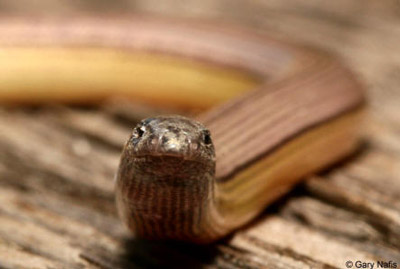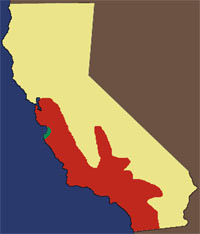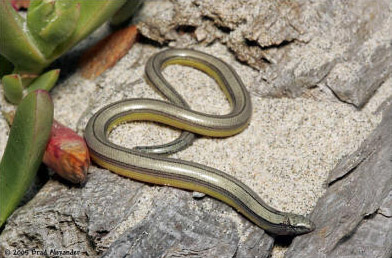Anniella pulchra
- Sensitive – U.S. Forest Service
- Species of Special Concern – California Department of Fish and Wildlife
- G3 Vulnerable – NatureServe (2016)
The deceptively snake-like California legless lizard is aptly named—it truly is a lizard with no legs! Two significant characteristics distinguish the California legless lizard from a snake: 1) it has moveable eyelids (snakes do not have eyelids at all); and 2) the California legless lizard can purposely detach the end of its tail to trick predators, a skill your average snake does not possess.
A Subspecies?
The California legless lizard is slender, and ranges in length from about 4 to 7 inches snout to vent. It has a shovel-shaped snout, smooth shiny scales and a blunt tail. It varies in color from metallic silver, beige, dark brown to black, and it typically has a dark line along its back and several thin stripes between scale rows along its sides. Aniella pulchra was formerly split into two subspecies (Aniella pulchra pulchra—Silvery Legless Lizard and Aniella pulchra nigra—Black Legless Lizard). Most herpetologists and state agencies no longer recognize the two subspecies.
Diet and Reproduction
California legless lizards often forage at the base of shrubs or other vegetation either on or just below the surface in leaf litter or sandy soil. Once they capture their prey, the lizard will pull it beneath the surface for consumption. The lizard enjoys feeding on insect larvae, termites, small adult insects, beetles and spiders. Known predators include alligator lizards, snakes, birds and small mammals.
Female California legless lizards are sexually mature at two to three years of age, and mating begins in late spring or early summer. They bear live young from September through November, and litter size ranges from one to four.
Range
Although the range of the California legless lizard is fairly extensive, it does not occur commonly within its full range. This lizard is common in suitable habitats in the Coast Ranges from Contra Costa County south to the Mexican border, but only has a spotty occurrence throughout the rest of its range, which includes the San Joaquin Valley to the west slope of the southern Sierra, the Tehachapi Mountains west of the desert and in the mountains of southern California. Its elevational distribution ranges from near sea level to 1800 meters (6000 feet).
Anniella pulchra has a wide thermal tolerance, which allows it to be active throughout the day, including colder mornings and nights. It is a burrowing species associated with sandy or loose loamy soils, and it lives mostly underground. The California legless lizard also needs moisture for its survival, so it favors moist, warm, loose soil with some plant cover. Thus the California legless lizard can often be found in sparsely vegetated areas of coastal dune, valley-foothill, chaparral and coastal scrub habitats.
Conservation Concerns
California legless lizards are very well documented in coastal dune habitats, but they do occur in the mountain areas on National Forest System lands. However, not much is known about their abundance on national forest lands. Scattered populations do exist in the Los Padres National Forest, specifically in the lower elevations of the desert scrub habitat of the Mt. Pinos Ranger District.
Although not much is known about the lizard, its habitat and threats, it does appear to be adapted to a variety of habitats. However, since they are dependent on duff and a litter layer for moisture, they are likely vulnerable to wildland fire (which will burn away the duff layer). Off-highway vehicle (OHV) use can trample lizards and their burrows. Additional threats to the lizard’s habitat include development, recreation (especially in coastal dune areas), and the introduction of nonnative plants (such as ice plant).
To help protect the California legless lizard and its habitat, ForestWatch is working to protect the chaparral ecosystems on which the lizard depends for survival. ForestWatch also supports efforts to control and manage the spread of invasive nonnative plants, to maintain the habitat condition of riparian areas and restore damaged areas, and to provide linkages to open space reserves outside national forests.









